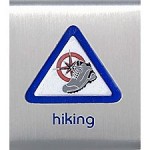Belt Loop

Complete these three requirements
- Explain the hiking safety rules to your den leader or adult partner. Practice these rules while on a hike.
- Demonstrate proper hiking attire and equipment.
- Hike at least 30 minutes with your adult partner, family, or den.
Sports Pin
Earn the Hiking belt loop and complete five of the following requirements.
- Make a chart and record at least five hours of hiking.
- Help plan a den, pack, or family hike.
- Earn Cub Scouting’s Leave No Trace Awareness Award.
- Earn the Cub Scout Outdoor Activity Award.
- Learn seven trail signs and tell your den leader or adult partner what they are.
- Be able to identify five different trees and five different birds on your hike. (These can be of the same species if multiple species are hard to find.)
- Using pictures or photographs, identify three poisonous plants. (Examples are poison ivy, poison sumac, and poison oak; oleander, etc.). Watch for these plants while on a hike.
- Take two different hikes for different purposes, for example, a nature hike, neighborhood hike, historical hike, city hike, stop-look-and-listen hike, and so on.
- Explain to your den leader or adult partner what a compass is and show how to use one on a hike.
- Explain to your den leader or adult partner what a global positioning system is and demonstrate how to use one on a hike.
- With visuals such as pictures or maps, report about one of your hikes to your den. Tell about how you prepared for your hike, who went with you, and what you saw..
Additional Information
Fun Hikes for Different Purposes
City Hike: Identify different buildings and businesses and talk about their use. Notice the different details of the buildings. Carefully follow safety rules.
Color Hike: Make a list of colors to find when you go hiking. Then, look for objects of the colors on your list and note what you saw.
Historical Hike: Hike to a historical spot. Know the history before going on the hike.
Nature Hike: While hiking, identify and discuss what you see in nature. Demonstrate how you show respect for nature.
Neighborhood Hike: Hike around your neighborhood and identify the homes, parks, schools, places of worship, and other areas of interest that are close to your home.
Stop-look-and-listen hike: Hike for a specific length of time or for a certain number of steps. Then stop and write down all you see and hear. Make several stops.
Hiking Gear
Take these outdoor essentials with you on your outdoor adventure. The items below may help you avoid emergencies and can make a pleasant hike even better
- Rain gear
- Full water bottle
- Trail food
- Flashlight
- Fanny pack or backpack to carry your items
- First-aid kit – personal and one per group
- Map and Compass – one per group
- Watch – one per group to pace your travels and return home when expected.
Hiking Safety
- Always tell someone where you are going and when you will return.
- Never hike alone or at night; use the buddy system.
- Dress properly for the weather and environmnet.
- Wear sun and insect protection.
- Take an extra pair of socks in case you need to change.
- Obey traffic signs and signals.
- Avoid hiking along roadways.
- Stay on the trail.
- Be alert to your surroundings.
- Don’t litter as you hike.
- Be alert to dangerous animals, insects, and plants. Never touch a wile animal.
- Take 1 pint of water for each hour you will be hiking. Never dink untreated water.

Resources
Hiking clubs/organizations, sporting good stores, local safety councils, and city parks and recreation departments often will have literature and other free resources.
American Hiking Society
http://www.americanhiking.org
Local Hikes
http://www.localhikes.com
Books About Hiking
Follow the Trail: A Young Person’s Guide to the Great Outdoors, by Jessica Loy. Henry Hold and Co., 2003
Trekking on a Trail, by Linda White. Gibbs Smith, 2000






